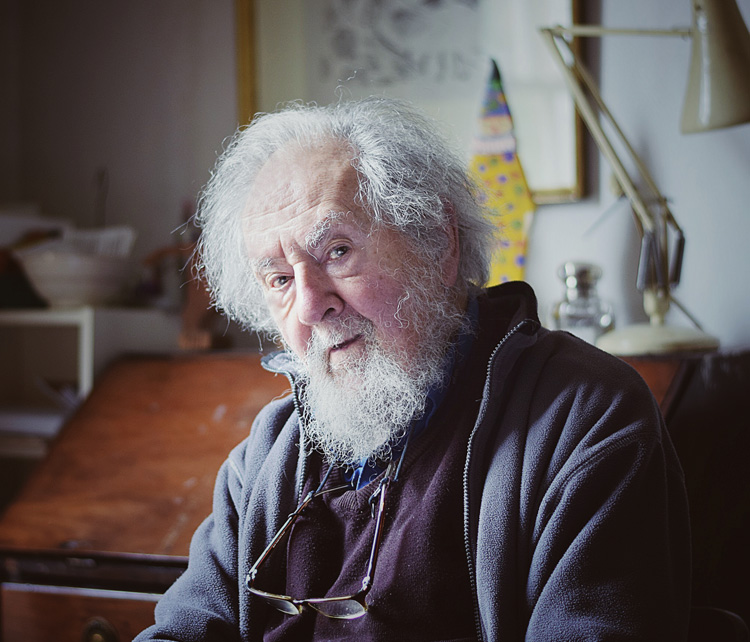
Anthony Eyton by Sarah Eyton, 2019. © Sarah Eyton.
by JULIET RIX
Anthony Eyton RA currently has a new exhibition of 38 pictures at Browse & Darby, London, almost all painted in the last couple of years. This would not be particularly remarkable for most professional artists, but Eyton is 96.
Having inherited an artistic bent from his mother, who died while he was still a child, Eyton started studying fine art in 1941 but, on account of the second world war, was called up to serve in the army the following year. He completed his education at Camberwell School of Art from 1947-50, before being awarded a scholarship to study in Italy.
Always a figurative painter, described by some as post-impressionist, he returned to Camberwell to teach from 1955 until the 80s, also teaching at the RA Schools for 35 years from the mid-60s. He has won numerous prizes, including the John Moores Painting Prize in 1972, and has been a Royal Academician since 1986. His works are owned by 17 British public collections, including the Tate and the British Museum.
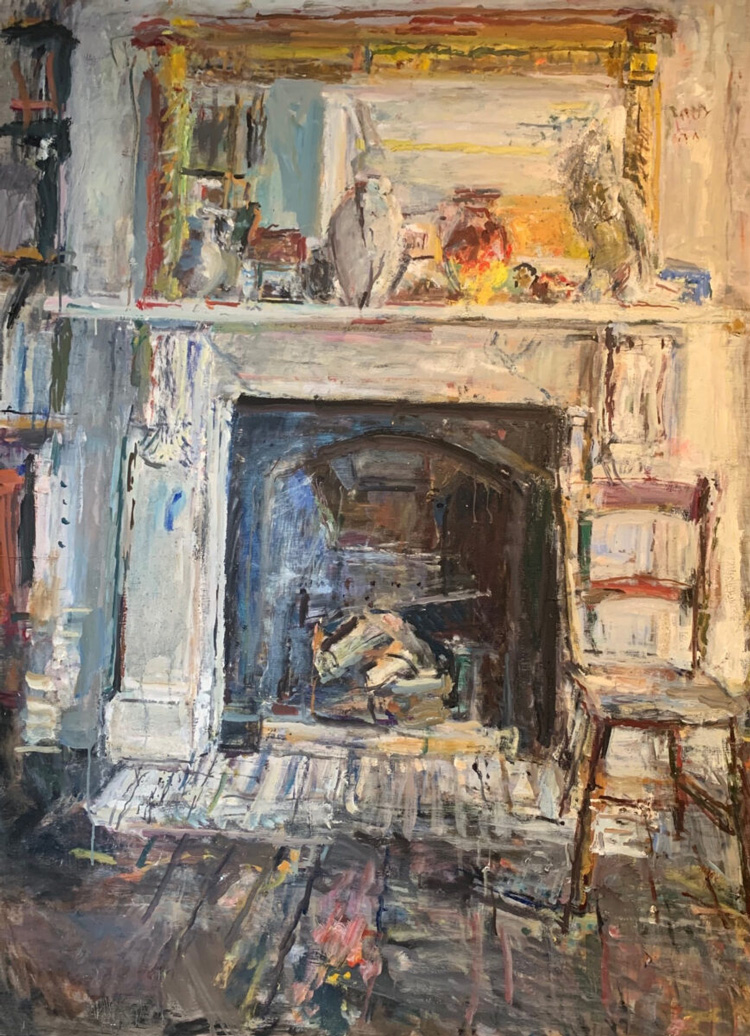
Anthony Eyton. Mirror, Chair & Fireplace, oil on canvas, 2019. Photo courtesy Browse & Darby.
He has lived in the same house in Brixton, south London, since 1960. Before the show, I visited him at this home/studio, a wonderful ramshackle Victorian town house with large windows looking out on to the road one side and a beautiful semi-wild garden on the other. Life and work mingle here: his mother’s paintings – an important influence – hang above the fireplace and on the mantelpiece sit rocks that feature in some of Eyton’s own recent paintings.
His portrait of his sister leans against the wall (she died in a car accident when she was 21) and other pictures dot the room. Next to Eyton’s favourite armchair stands a piano, on top of which are a bronze horse and a white cone, seen again in the painting that sits on a nearby easel awaiting completion in time for the show. There is a copy of Studio International, too. It is from 1925 and belonged to his mother.
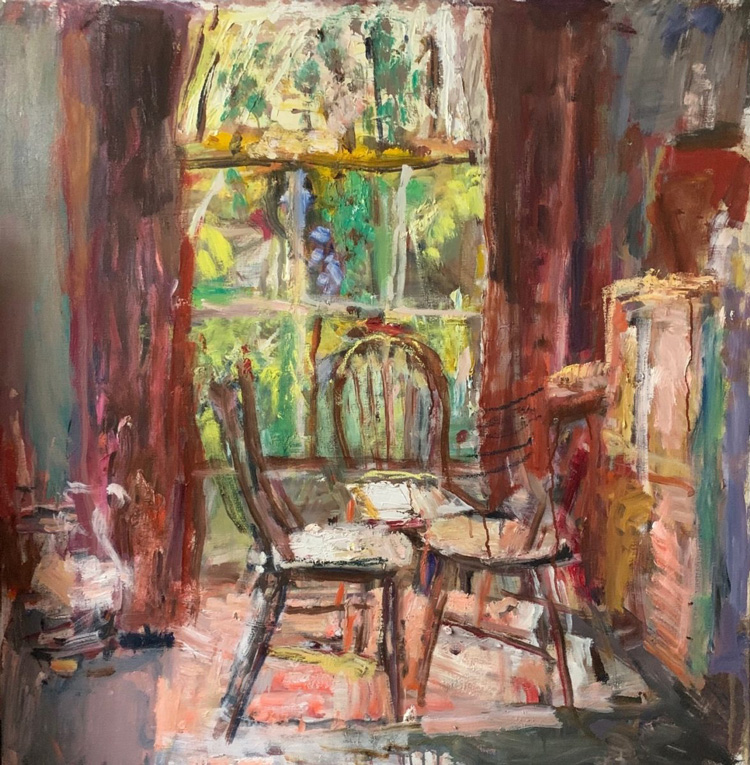
Anthony Eyton. Three Chairs in the Studio II, 2019. Photo courtesy Browse & Darby.
The side studio – once the garage – is full of larger paintings inspired by Eyton’s travels, including to India and Lourdes, as well as work based more locally in London. Up the staircase (that also features in the new exhibition), in a light first-floor studio, are chairs piled with paints, shelves full of books, and more work in various stages of completion.
It is a quintessential artist’s residence and the ideal place for a chat about Eyton’s long life, and work.
Juliet Rix: Having an exhibition that is almost entirely new work at 96 isn’t bad is it?
Anthony Eyton: No. And I’ve got a lovely letter from Frank Auerbach. He says he can’t get to the exhibition because he’s not as mobile as he used to be, but he loved the catalogue and thought my paintings now were the most original ones I’ve painted. It’s quite something to be doing your best work in your 90s!
JR: You have been making art since you were very young and your mother, Phyllis Eyton, was a key influence, wasn’t she?
AE: My mother kept a diary, so I know she was very interested in my childhood drawings. She had hopes, I think, that I might be a painter. Then she had this ghastly accident when she was 29 and I was six-and-a-half – a hunting accident. She wasn’t very good at riding and she was quite accident prone (she’d driven into ditches once or twice), but she wanted to ride and do these country pursuits. The horse wouldn’t take this jump. She tried twice and the third time she came off. She died three days later. I wasn’t allowed to the funeral. I was considered too young. But that made it unreal.
My father chose this beautiful place to tell me. He took me to Decoy Pond in Aldermaston, (Berkshire). There were bridges over the waterway, I remember – it was a place my mother loved – and told me: “She’s gone to heaven.” It was never real.
JR: That’s very difficult for a six-year-old child. How did you deal with it?
AE: I’m still dealing with it. That’s what the paintings are about perhaps. [He points to the paintings by his mother on his wall]
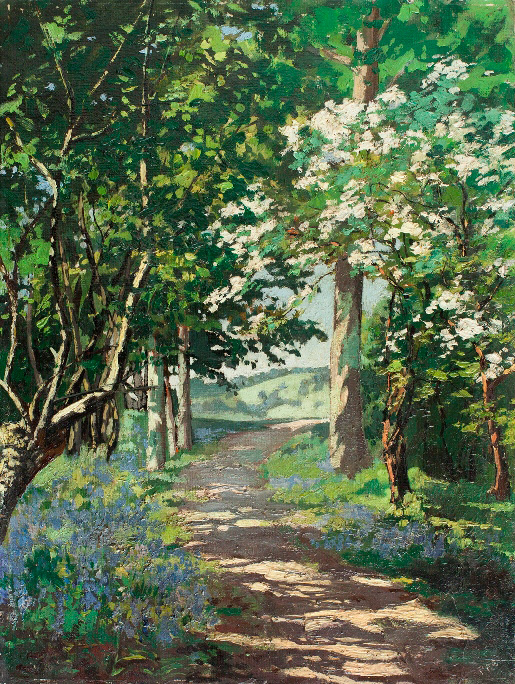
Phyllis Eyton, The Be-Loud Glade. Oil on board, 16 x 12 in. Photo: Juliet Rix.
That one of the path – the way it catches the sunlight. I couldn’t begin [to do that]. It’s unreachable for me – that directness. But we have certain things in common: a joy in colour and light and spontaneity and wanting to paint. Excitement. That goads me on.
JR: It sounds as though you have almost spent your life trying to do it as well as her?
AE: Yes, in a way. Every day I sit and look at her work. It’s so direct, so in touch with her feelings. [He points to another of his mother’s paintings – a picture of a tree in blossom] That’s the painting she got into the Royal Academy Summer show the summer before she died. She did a dance of joy when she heard it had been selected. My father didn’t believe it – he had to see it in writing. It gave her new courage. She started painting bigger.
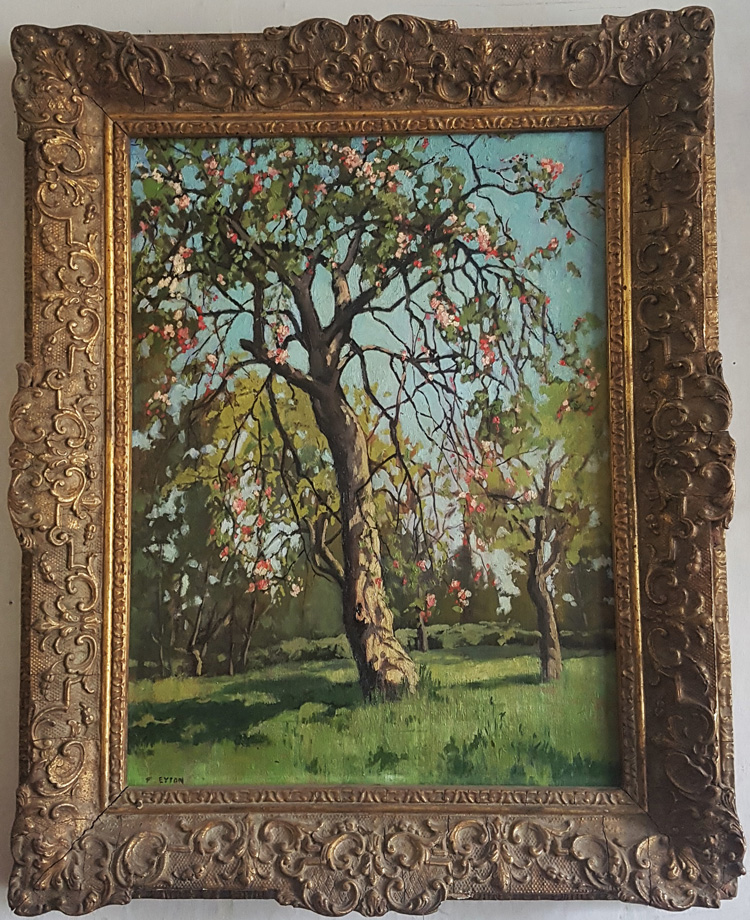
Phyllis Eyton's Royal Academy of Arts Summer Exhibition painting. Photo: Juliet Rix.
Thank goodness [the picture] wasn’t sold. You could say it’s sort of perfect in a way, though that’s a silly word to use. All I can do is flounder about trying to emulate her. It’s a sort of a target, but also a cross. A bit of a binding thing.
Of course you also have to go your own free way. I’m not really bound now. I hope I’ve found a way. It’s important to just paint – that’s all that matters.
JR: Do you still work every day?
AE: I work every day if possible. Up at 7am. Muesli with fruit and coffee (I like knowing what people have for breakfast). The difficulty is paperwork that doesn’t get done. I hope to start working at 10 and go on until 1.30 or 2.
In the winter, I’ll be doing night pictures out of the window with the street lights. At night, the light is the same. The sun is rather problematic – it keeps changing!
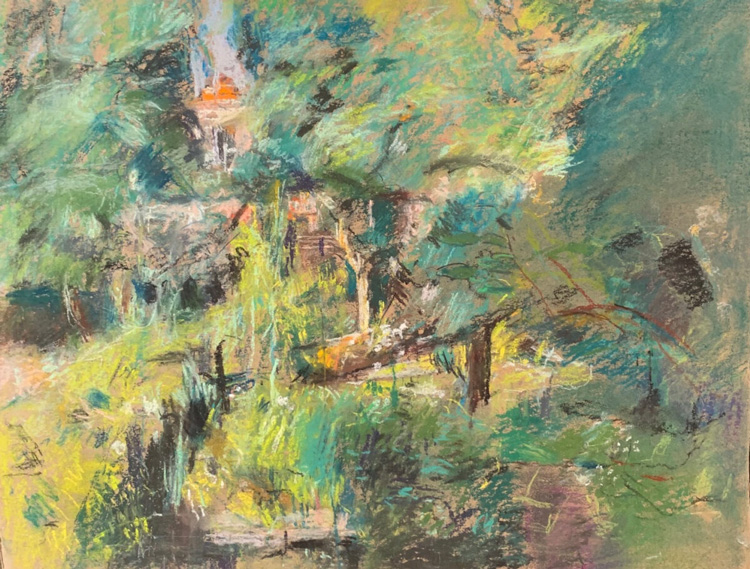
Anthony Eyton. Brixton Garden, 2014. Pastel on card, 18 1/2 x 24 in. Photo courtesy Browse & Darby.
JR: You never complete a painting in one session do you, but return to it time and again?
AE: Yes, 20 or 30 times. They are in a state of flux. Sometimes I will put one aside and take it up again years later, like the Grotto at Lourdes, which was started after several visits [in the 1990s]. The pastels I made on the spot are now feeding into a big canvas [for the coming exhibition].
JR: It looks as if you are still working on paintings that are about to go to the gallery for the exhibition.
AE: Yes. I’m afraid it’s a sort of disease this last-minute stuff. One falls into some sort of trap; this horrible deadline business. Perhaps you get on to a higher level, or perhaps it’s lower. My daughter took photos of [a painting I did] and later she said: “Why didn’t you stick to that?” And she had the photographic evidence and it was finished and perfect, but I went on for another year! Underneath [my paintings] there are a lot of versions that could have been as good.
[As the show was being hung, Eyton decided to make a change to The Grotto, Lourdes, taking out a foreground figure. In my opinion, it did improve the picture, making it stronger, making space for the viewer in the scene and making the rocks of the grotto protrude more into the viewer’s space. Both versions are included here – albeit only from reproduction – so you can make up your own mind. JR].
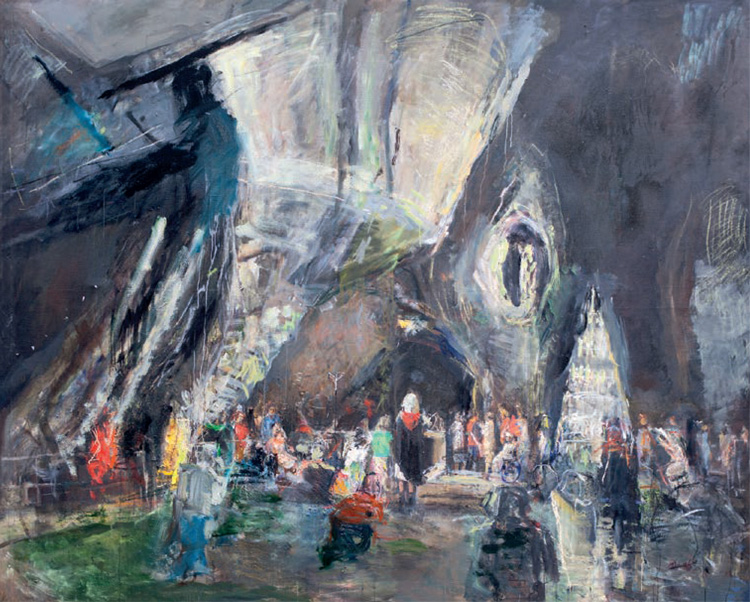
Anthony Eyton. The Grotto, Lourdes, 1996-2019. Oil on canvas, 76 1/4 x 94 1/2 in. Photo courtesy Browse & Darby.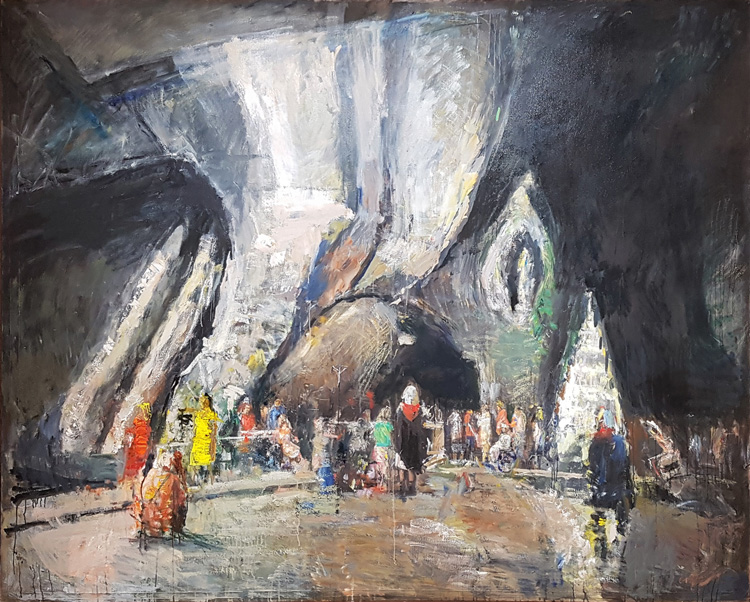
Anthony Eyton. The Grotto, Lourdes. Final exhibition version. Photo: Juliet Rix.
JR: I gather you have just changed a picture of Brixton Road that had already sold?
AE: Yes. I’ve taken out a car. If they don’t like it, I’ll put it back in for them. [He did.] I think it could be more direct now … but it may have lost something – who knows? You do leave some history of a painting in it. It accrues … suggests other things.
-JR.jpg)
Anthony Eyton. View to Brixton Road, 2019. Oil on canvas, 62 x 27 3/4 in. (With car put back in). Photo: Juliet Rix.
JR: How do you paint?
AE: I use paintbrushes this long [indicating about a metre]. I can’t stand up to paint any more. I have to sit, so it seems to make sense. You get more of a flow – or an attack.
JR: You don’t make much distinction between interior and exterior scenes. You seem to treat them much the same. Is that fair?
AE: Very fair and it’s always been so. In the catalogue [for the new show] they’ve been very perceptive in putting Lourdes [a large outdoor scene] opposite the stones [Erratic Stones II - an interior of pieces of rock on his mantelpiece]. There is a sort of similarity [between them]. Whether it’s landscape or interiors, it’s all the same really in the end. The inability to pin it down as my mother did. It’s all floating around but means something moving and transient and suggestive that can’t be pinned down.
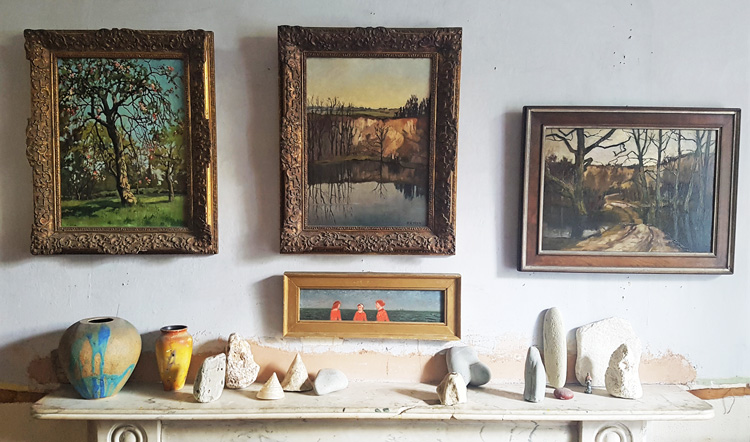
Anthony Eyton's home – mantelpiece with erratic rocks, and three of his mother's paintings, and one below by Richard Eurich. Photo: Juliet Rix.
I do believe I’m hardly responsible, one is a kind of conduit between the universe, the eternal verities, something completely magic and mysterious, and present life. Zen comes into it: when you are not trying to do something, it happens. It’s a mysterious process, but you’re up against mystery in the first place and if you can put yourself in thrall to that, open to it … I’m at the receiving end. Smitten [by a subject]. I do not choose the chairs, they say to me “Paint me” and I’m smitten. I am their servant.
JR: You have described yourself as a perceptual rather than a conceptual artist. Has it been difficult being a figurative painter through a period when abstract and conceptual art has dominated?
AE: It has been tricky. I couldn’t be an abstract painter because I’d have no idea what sort of abstraction to do, but I think [my paintings] are intensely abstract in content, which is why I like abstract painting, too. I love it. Gillian Ayres, the abstract expressionists and so on, Bridget Riley. And that’s two women artists. That has been a wonderful change around. When I was teaching at Camberwell, there was only one woman teacher!
I said to Philip Matthews, who was head of painting: “You have no women on your staff.” He went rather white and said: “Well, name one good woman painter.” [Eyton looks incredulous] It was like that. But Carel Weight, who taught at the Royal College of Art, started buying women’s paintings and went out of his way to support them. Now it’s all changed. Now the world is full of women artists – and they are marvellous painters. There’s a surge, like the impressionists had a surge. It’s the age of women.
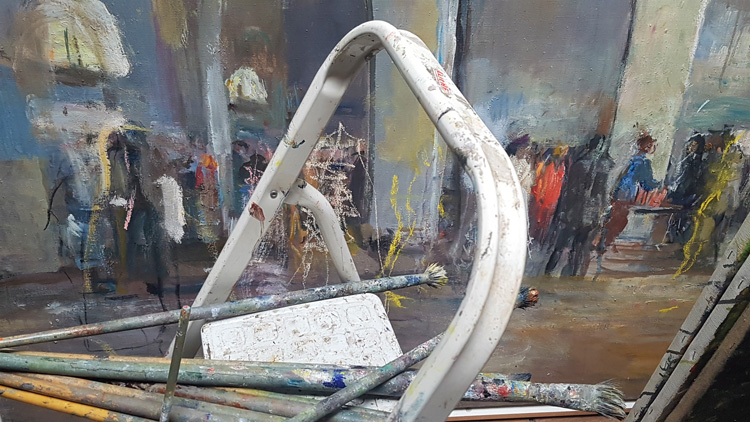
Paint brushes in Anthony Eyton's studio, 2019. Photo: Juliet Rix.
JR: Did you enjoy teaching?
AE: Oh, yes.
JR: What is taught has changed too, hasn’t it?
AE: I don’t think it is teaching you how to use your hands any more. The most primitive thing you can think of is to make marks on the rockface with your hands. Art schools now are generally about using the brain and the machine and not to have the hands-on doing.
JR: Having lost your mother, did your father encourage your painting?
AE: He was always very positive about me painting. He gave me my mother’s paintbox when I was about 14. It was a 16 x 12 – all the old paints and brushes were there. I used to go out to paint with her paintbox. It got stolen in the end – in Egypt, on a train.
JR: You’ve travelled quite a lot, and you seem to be drawn to places with crowds or groups of people (as subjects)?
AE: I’m very interested in gatherings, especially with religion. There’s Lourdes, which is Roman Catholic, and then, when I think of it, my Indian pictures have always been about religion – the Hindu bathing in the Ganges (at Varanasi). And the Western Wall in Jerusalem. I think I’m interested in beliefs. I did a big painting of Reclaim the Streets in Brixton in the late 80s or 90s when they all sat down in the road. That’s a belief, too. So is a shopping mall – a belief in Mammon. That’s a bit glib. It’s just I like drawing people where they are – that’s all, but if you want a narrative you’ve got this belief.
JR: Besides your mother, who were your main influences?
AE: Early influence – Piero della Francesca. I was crazy about him. Going for two years on a scholarship to Italy, it was an enormous influence seeing Masaccio and Michelangelo in situ. And that’s where I think a love of people came in. When you come to think of it, most Italian painting is about people not landscape.
JR: You paint landscapes as well.
AE: Oh yes, yes. In Italy, I went round from place to place doing landscapes. When I was at Canford School in Dorset, William Coldstream came to lecture. It was very enlightened art teaching there (as opposed to the usual rugger). Ian Fleming-Williams was the art master and he was an expert on Constable. So my first influence was probably Constable. But one rather takes Constable and Turner for granted – they’re in one’s blood. It’s easy to say one’s influences are Piero della Francesca, Titian, Chardin, Cézanne because they were the main force. But Constable was sort of innate in your blood. You grow up with them and think like them, really. Then you broaden your mind.
It’s important to keep that going!
• Anthony Eyton – Dilemmas & Solutions is at Browse & Darby, London, until 29 November 2019.